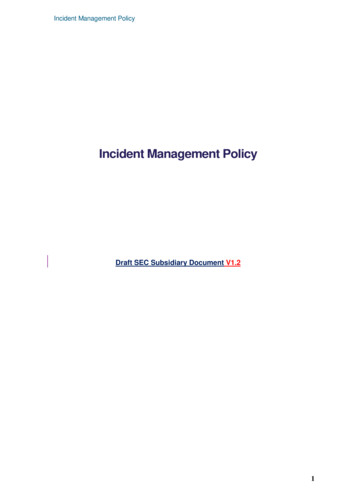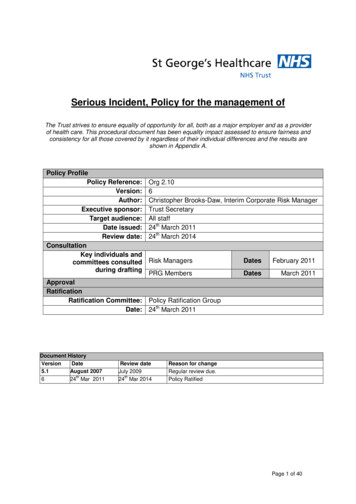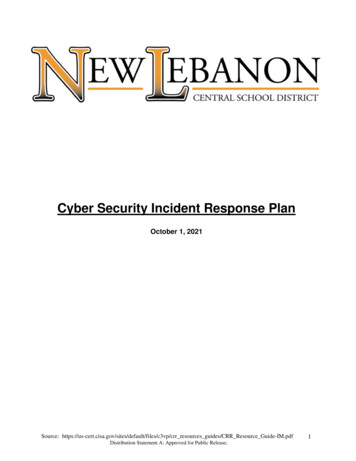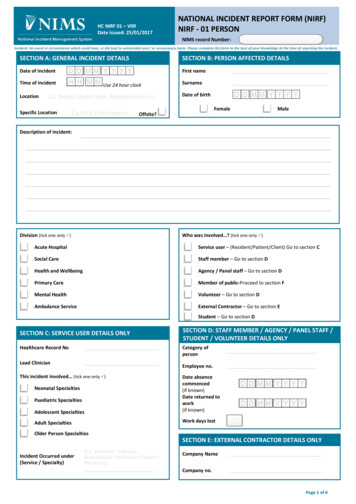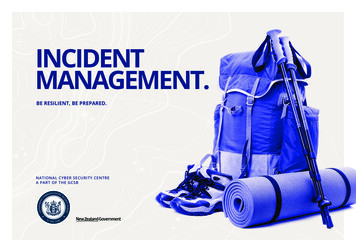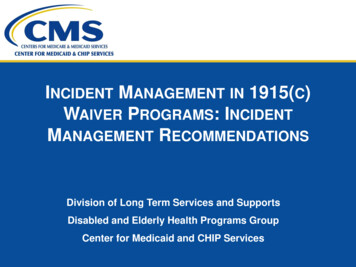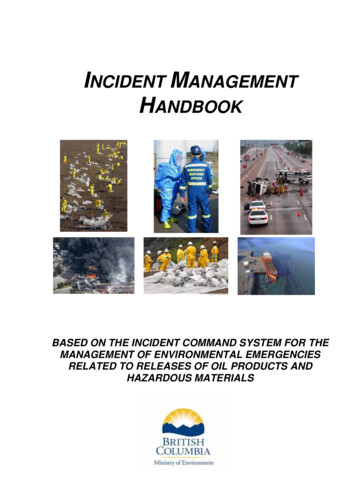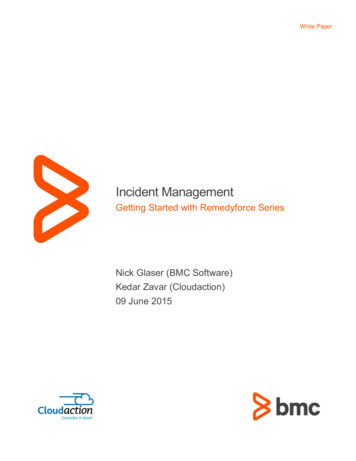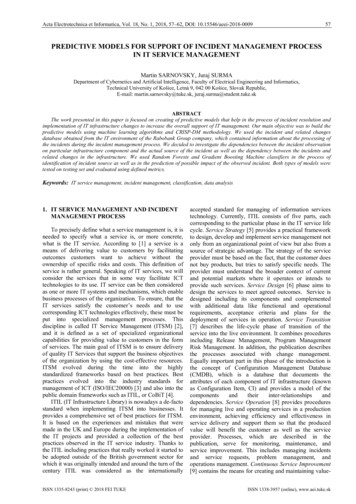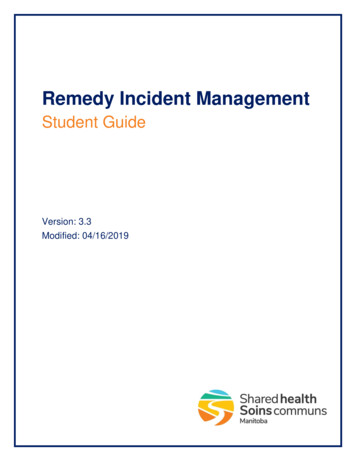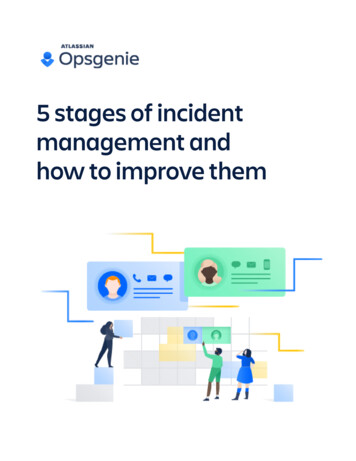
Transcription
5 stages of incidentmanagement andhow to improve them
Contents01Getting started02Preparation04Detection & Alerting06Containment09Remediation11Analysis13In Summary
Getting startedSimply put, effective incident management is an essential part of all enterprisebusiness systems. Why? Because as tech tools and workflows becomeincreasingly complex and interconnected, systems become increasinglyvulnerable to unplanned downtime. Downtime that can hit any system at anytime - with potential impact to both internal and external business operations.Costs for incidents are typically measured in tens, if not hundreds, of thousandsof dollars per minute.With such potential impact on the line, organizations are rapidly evolvingincident response practices to ensure they can be managed as quickly andeffectively as possible. This means taking a holistic approach to an incident,understanding how it evolves, and how to continually improve the resilienceof systems. From an academic perspective, there are several opinions on howmany stages are associated with a typical incident response workflow.While this may be different for varying organizations, we’ll focus on thefollowing five stages to represent the incident lifecycle:1. Preparation2. Detection & Alerting3. Containment4. Remediation5. AnalysisWithout consideration of each of these stages, organizations are exposingthemselves to the risk that incidents will be mismanaged, resulting inunnecessary delays and associated costs. Below, we will look at each ofthese stages, and offer recommendations on practices that will help teamsaddress incidents more efficiently.01
PreparationEven the most experienced IT professionals will say that Preparation is anessential, yet often overlooked, part of incident management. It’s the stagewhere teams explore “what if” scenarios and then define processes toaddress them.Leading organizations make a point of focusing on Preparation in the sameway that athletes practice a sport. The goal is to build muscle memory aroundincident response so reactions can be faster.“Incident response methodologies typically emphasize preparation — notonly establishing an incident response capability so that the organization isready to respond to incidents, but also preventing incidents by ensuring thatsystems, networks, and applications are sufficiently secure.”NIST02
Ideas for improvementAlways pack a jump bag.A “jump bag” for incident responders is a repository of critical informationthat teams need to respond with the least amount of delay. By centralizingthis material into a single location, teams have knowledge at their fingertipsinstead of needing to search for it. Depending on the structure of anorganization’s teams and systems, this could include a variety of things: Incident response plansContact listsOn-call schedule(s)Escalation policies Links to conferencing toolsAccess codesPolicy documentsTechnical documentation & runbooks Don’t run from Runbooks.Runbooks offer team members essential guidance on what steps to take ina given scenario. This is especially important for teams that work onrotational schedules and/or where a system expert may not be immediatelyavailable. Without runbooks in place, responders unfamiliar with a system areleft spending cycles attempting to determine what steps need to be taken tobegin remediation. A well maintained set of runbooks not only allows teamsto respond faster, but also collectively builds a knowledge base that supportsthe continuous improvement of incident response practices. Embrace chaos, promote stability.As a term “Chaos Engineering” seems like an oxymoron. It’s not. It’s thepractice of experimenting with systems by knowingly injecting failure - inorder to understand how systems can be built more robustly. An exampleof this is Chaos Monkey. Originally developed at Netflix, Chaos Monkey is atool that tests network resiliency by intentionally taking production systemsoffline. While seemingly dangerous, the practice actually helps engineerscontinually test systems to ensure recoverability. Ultimately, Chaos Monkeyhelped teams at Netflix build a culture around system resiliency. With thissuccess, many other organizations have followed suit in this practice.03
Detection & AlertingIncident Detection is not only focused on knowing that something is wrong,but also on how teams are notified about it. While these two may seem likeseparate processes, they are in fact very connected. The challenge is thatwhile the proliferation of available IT monitoring tools has greatly improvedthe ability for teams to detect abnormalities and incidents - monitoring toolscan also create “alert storms” or false positives that complicate the responseprocess.Top IT teams add a layer onto the monitoring process to ensure alerts aremanaged properly. This layer acts to centralize the alerting process, whilealso building in additional intelligence to the way alerts are delivered.“Detection should lead to the appropriate response. This primarily call for theneed to clearly identify and communicate the roles, responsibilities as well asthe initia approach for incident handling. It should include determination ofwho shall identify the incident and determine its severity as a means tohandle the incidenteffectively within the organisational context.”MITA04
Ideas for improvement Think outside the NOC.Historically, Network Operations Centers (NOCs) acted as the monitoringand alerting hub for large scale IT systems. The challenge is that a typicalNOC engineer can be responsible for the triage and escalation of incidentsfrom anywhere in the system. Modern incident management tools allow forthis process to be streamlined significantly. By automating alert deliveryworkflows based on defined alert types, team schedules, and escalationpolicies, the potential for human error and/or delays can be avoided. Aggregate, not aggravate.Nothing is worse than receiving a continual barrage of alerts coming frommultiple monitoring tools. By centralizing the flow of alerts through a singletool, teams are able to better filter the noise so they can quickly focus onmatters that need attention. Knowledge power.A basic alert conveys something is wrong, but it doesn’t always expresswhat. This causes unnecessary delays as teams must investigate anddetermine what caused it. By coupling alerts with the technical details ofwhy it was triggered, the remediation process can begin faster. Quis custodiet ipsos custodes?The latin phrase “Who’s guarding the guards?” identifies a universal problemfaced by all IT teams. This is because the monitoring tools they employare as equally vulnerable to incidents and downtime as the systems theyare designed to protect. Without a way to ensure monitoring tools arefunctioning properly, systems could easily go offline without notification.Holistic alerting processes ensure that both the systems, and the tools thatmonitor them, are continually checked for health.05
ContainmentThe triage process for an IT incident is similar to processes deployed inmedical fields. The first step is to identify the extent of the incident. Next,the incident needs to be contained in order to prevent the situation fromgetting worse. All actions taken in this phase should be focused on limitingand preventing any further damage from occurring.“Short-term containment is not intended to be a long term solution to theproblem; it is only intended to limit the incident before it gets worse.”R. BEJTLICH, THE BROOKINGS INSTITUTE06
Ideas for improvement Stop the bleeding.A triage doctor knows that they are risking greater harm if they get boggeddown in attempting to resolve all situations as they arrive. Their focus ison short term actions that stabilize a patient enough to move them alongto more acute care. In tech fields, containment actions focus on temporarysolutions (isolating a network, regressing a build, restarting servers, etc.) thatat a minimum limit the scope of the incident or, more ideally, bring systemsback online. If incident management efforts focus purely on remediation,and not containment, an outage can be extended unnecessarily while apermanent solution is being found. Don’t go it alone.Hero culture in IT teams is a dying philosophy. No longer is it fashionableto be the lone engineer who works endless evening and weekend hoursbecause they are the only person who can bring systems back online.Instead, teams are working as just that, teams. Collaborating on issuesbecause they understand that incidents can be resolved faster throughshared knowledge. Conference lines, chat tools, and live video feeds thereforebecome essential elements of the incident management toolbox. These canquickly bring teams together so they can collaborate in real time. It’s alsocommon for teams to integrate chat tools with incident management toolsso incidents can be triggered, acknowledged, and resolved from a singleplatform.07
Be transparent.The digital age makes seemingly endless amounts of informationavailable at any time. In the midst of an IT meltdown, this can be anadvantage - or disadvantage. If users are met with a service disruption,it’s common for the incident to be made public in short order. To stayahead of this, teams should have an incident communication plan inplace. The goal is to build trust with customers by publicly acknowledgingthat a disruption is taking place, and to ensure them that steps are beingtaken to resolve it. Tools like Twitter, StatusPage, and user forums aregreat places to share this information. Importantly, this process shouldbe designed to continue through the remediation and analysis phases tofurther grow trust with users that may otherwise abandon a system.08
RemediationClosely tied to Containment is Remediation. Here is where long-termsolutions are implemented that ensure the incident has been addressedcompletely and effectively. Where in Containment, the goal may be to bringsystems back online, in Remediation the goal shifts to understanding whatcaused the problem and how it can be corrected to prevent similar incidentsfrom occurring in the future.“Prior to full system recovery, remediation efforts should be performed to fixthe source of the problem. The final stage of recovery is to not just restorethe system to where it was, but rather to make it better and more secure.The system should have the same operational capabilities, but it alsoshould protect against what caused the incident in the first place.”US DEPARTMENT OF HOMELAND SECURITY09
Ideas for improvement Cynefin.A decision making framework, Cynefin (pronounced “KUN-iv-en”) providesa structured way to approach problems that helps incident respondersdetermine the best course of action based on the nature of the problem itself.Depending on the type of incident (simple, complex, complicated, chaotic),an approach to solving it can be defined. Does the incident have a known cause and solution? Do I need to involve additional people to help address an incident? Is there time to probe the problem to identify the best response, or doesthe situation require immediate action? Automate much?Chat tools have become a defacto tool for organizations to improvecommunication and collaboration. Yet chat tools have also evolved far pastsimply enabling teams to send messages. The software development teamat GitHub pioneered the evolution of chat tools when they released theopen source tool, Hubot. Hubot allows users to trigger actions and scriptsdirectly from a chat environment. This allows teams to simplify operations bycreating bots that automate processes (initiating a server restart, deployinga snippet of code, etc).10
AnalysisIncident management workflows don’t end once the dust has settled andsystems have been restored. Now begins one of the most important phasesof the incident management lifecycle: Analysis. The intent of a “postmortem”analysis is to clearly understand both the systemic causes of an incidentalong with the steps taken to respond to it.From here, leading teams work to identify improvement opportunities aroundthe systems and the processes defined to maintain them. By evaluating thisinformation, teams can develop new workflows that support higher systemresilience and faster incident response.“The (post-incident analysis) should be written in a form of a report to provide aplay-by-play review of the entire incident; this report should be able to answerthe: Who, What, Where, Why, and How questions that may come up duringthe lessons learned meeting. The overall goal is to learn from the incidentsthat occurred within an organization to improve the team’s performance andprovide reference materials in the event of a similar incident.”SANS INSTITUTE11
Ideas for improvement Learn from failure.Overwhelmingly, IT teams will say that they only take the time to review“major outages.” While this is a good start, it often overlooks smallerincidents that may have a lingering impact. A detailed postmortem reportmay not be necessary for all incidents, but a brief review of the detailsshould always be done. This way, awareness of a situation supports theadvancement of communal knowledge and continuous improvement. There is no root cause!Or is there? When analyzing an incident, it is rare that a single identifiable“root” cause can be named. According to the Cynefin model, these wouldfall into the category of “simple” incidents where the cause and necessaryresponse are known and repeatable. It’s rarely that easy. Often systemsare far too complex and interdependent to define a single root cause of anincident. Even if the root cause seems apparent (say a keystroke error thatcrashes an application), there is usually cause to understand what externalfactors may have allowed the application to crash (or not prevented it). Be blameless.The goal of every postmortem should be to understand what went wrongand what can be done to avoid similar incidents in the future. Importantly,this process should not be used to assign blame. That’s because teams thatfocus on the “who” and not the “what,” let emotions pull the analysis awayfrom truly understanding what happened.12
In SummaryIn modern IT environments, change is the only constant. This meanssystems will continually be stressed in new and different ways. Teamsthat understand this, also understand that it’s not a matter of if - but when- systems will fail. Taking steps to prepare for these failures should berecognized as a critical element of ongoing success, and integrated into theDNA of engineering teams.About OpsGenieOpsGenie is a modern incident management platform for operating alwayson services, empowering Dev & Ops teams to plan for service disruptions andstay in control during incidents. With over 200 deep integrations and a highlyflexible rules engine, Opsgenie centralizes alerts, notifies the right peoplereliably, and enables them to collaborate and take rapid action. Throughout theentire incident lifecycle, Opsgenie tracks all activity and provides actionableinsights to improve productivity and drive continuous operational efficiencies.Contact your Solution Partner todayto learn more about Opsgenie13
ResourcesAlerting & Incident Management: Supporting custom alert properties How to enhance collaboration during an incident 5 Common incident response problems (and their solutions)Cynefin The Cynefin Framework The Cynefin Framework videoChatOps Slack Opsgenie integration video ChatOps and Hubot at GitHubChaos Engineering http://principlesofchaos.org/ Chaos MonkeyPost-incident Analysis Incident Tracking with Opsgenie14
From an academic perspective, there are several opinions on how many stages are associated with a typical incident response workflow. While this may be different for varying organizations, we'll focus on the following five stages to represent the incident lifecycle: 1. Preparation 2. Detection & Alerting 3. Containment 4. Remediation 5.

